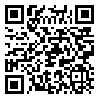قابل توجه نویسندگان محترم، مقالاتی که از تاریخ 1404/07/13 برای نشریه ارسال می شوند، شامل پرداخت هزینه بررسی نخواهند شد.
Volume 6, Issue 1 (Semi-Annual 2022)
JIC 2022, 6(1): 133-146 |
Back to browse issues page
Download citation:
BibTeX | RIS | EndNote | Medlars | ProCite | Reference Manager | RefWorks
Send citation to:



BibTeX | RIS | EndNote | Medlars | ProCite | Reference Manager | RefWorks
Send citation to:
Emami Far N, Norouzizadeh M. (2022). Iconology of Heaven and Hell in Religious Murals of Qajar Period (Case Study of Pir Rudband Dezful Tomb). JIC. 6(1), 133-146. doi:10.52547/jic.6.1.133
URL: http://jih-tabriziau.ir/article-1-134-en.html
URL: http://jih-tabriziau.ir/article-1-134-en.html
1- Faculty of Arts, Shahed University
2- Payame Noor Ahvaz ,Marjannorouzi@yahoo.com
2- Payame Noor Ahvaz ,
Abstract: (4582 Views)
Mural painting in Iran has been considered by artists and art critics for thousands of years. Paintings The image of heaven and hell is a part of the decoration of tombs in the Qajar period, which is known as the most important issues in the hereafter. In sacred buildings, this theme connects with the religious beliefs of the common people and the painter's aesthetic imagination, and creates a link for the transmission of spirituality, mysticism and religious sincerity in the context of society. The issue raised is related to the drawing of the image of heaven and hell in the mural of the tomb of Pir Rudband in Dezful in Khuzestan, which is the only surviving pictorial work from the Qajar period in this province, due to the religious nature of this city, style and The painter's context has a special semantic reflection in the creation of paintings.
It can be said that the design and execution of these paintings was unique in its time. Therefore, the purpose of examining this remaining artistic treasure is to use a new approach and a new perspective in the field of art criticism and aesthetics, which is done according to the model of iconology. To find the authors' answers in a descriptive-analytical way, two frames of the tomb of Pir Rudband Dezful with the theme of "heaven and hell" with an iconological approach, the study of the painter and the training he received in Isfahan during the Qajar period, was able to form By combining religious, Iranian and Western elements, the designs create images that, by analyzing them, revealed that each of them has a meaning in order to create a spiritual and spiritual connection to the audience with the arrival of the pilgrims. Execution of paintings on top of the building makes this feature more evident.
The present research is descriptive-analytical and its research method is iconology. This method has many capabilities in explaining, analyzing and interpreting historical works of art. So first by describing the iconological approach defined by Panofsky; Will be explained. And then to mural painting in Iran and the background that has passed until the Qajar period. During this period, important factors in mural painting have had an impact. Among the religious themes, in the sacred buildings, which distinguishes it from the court frescoes. Meanwhile, the city of Dezful, which is one of the religious cities in different historical periods of Iran. There is a famous tomb called Pir Rudband with a fresco on the other side (heaven and hell), which has become special. The study of the murals of this building, with the iconology approach, includes pre-iconographic description, iconographic analysis and finally the interpretation of iconology. Data collection has been done by library, documentary and field methods.
It is worth mentioning that the execution of paintings in the upper part of the building makes this feature more evident. And engage the pilgrims in spiritual communication as they enter. It is worth mentioning that the execution of paintings in the upper part of the building makes this feature more evident.
Type of Study: Original Research |
Subject:
2
Received: 2021/11/13 | Accepted: 2022/08/23 | Published: 2022/11/23
Received: 2021/11/13 | Accepted: 2022/08/23 | Published: 2022/11/23
Send email to the article author
| Rights and permissions | |
 |
This work is licensed under a Creative Commons Attribution-NonCommercial 4.0 International License. |






 tabriziau.ac.ir
tabriziau.ac.ir